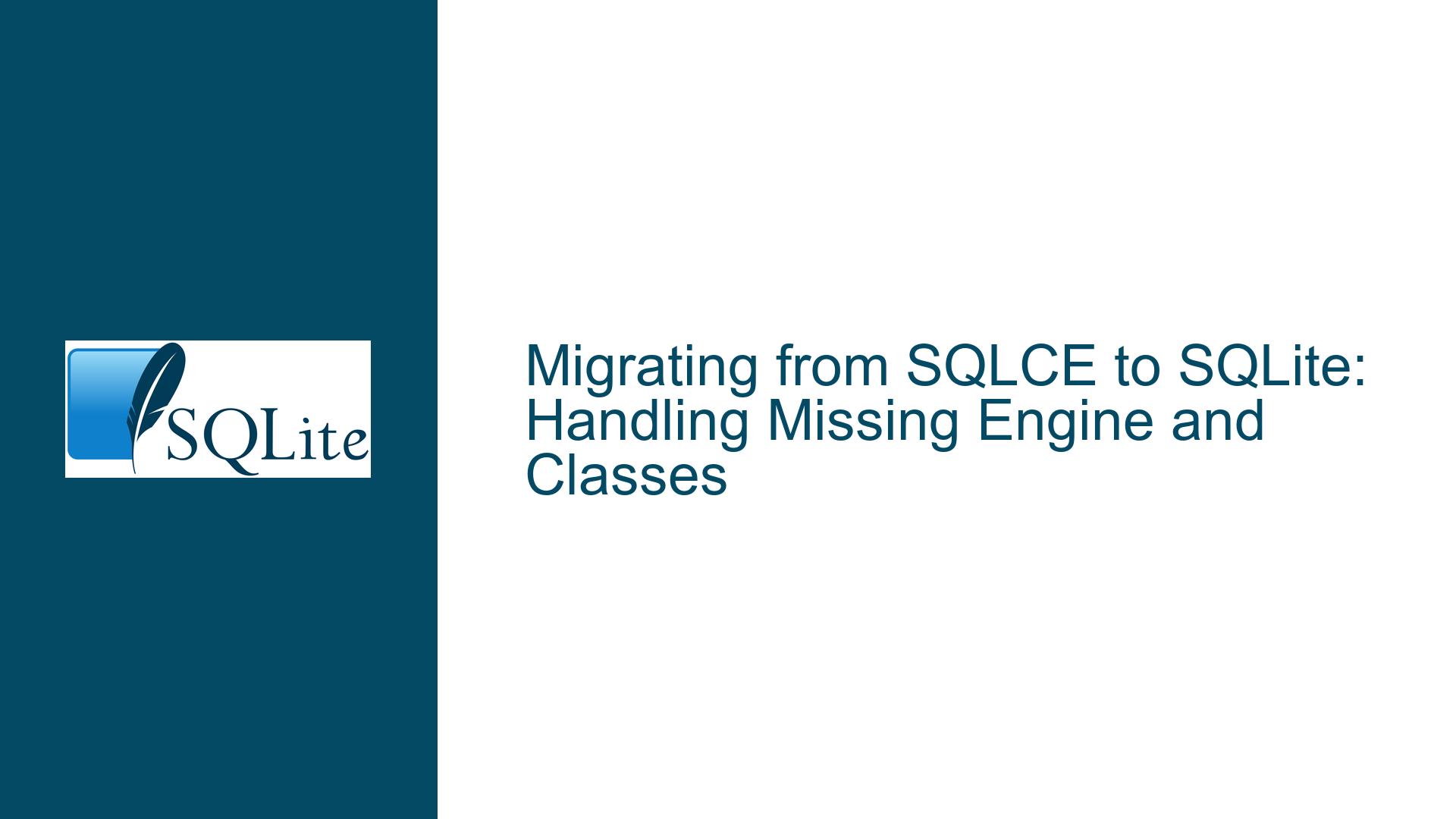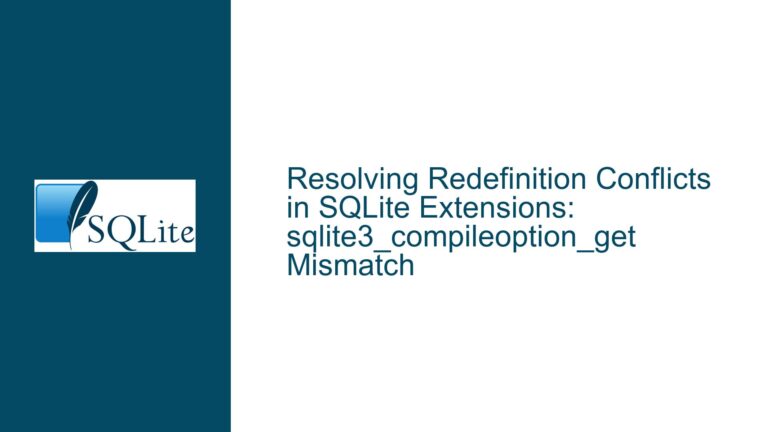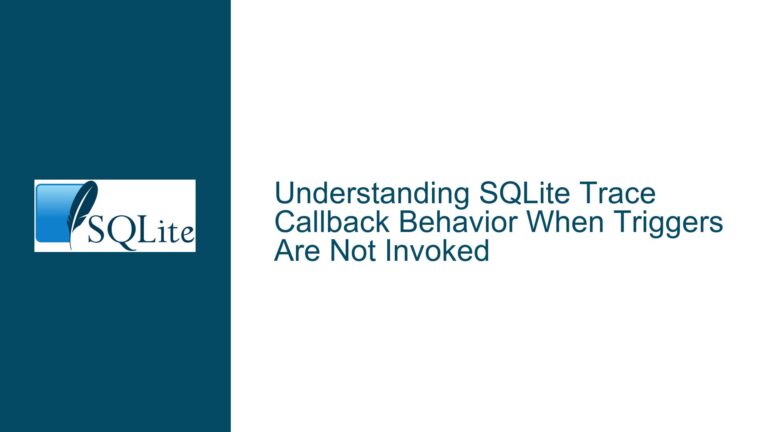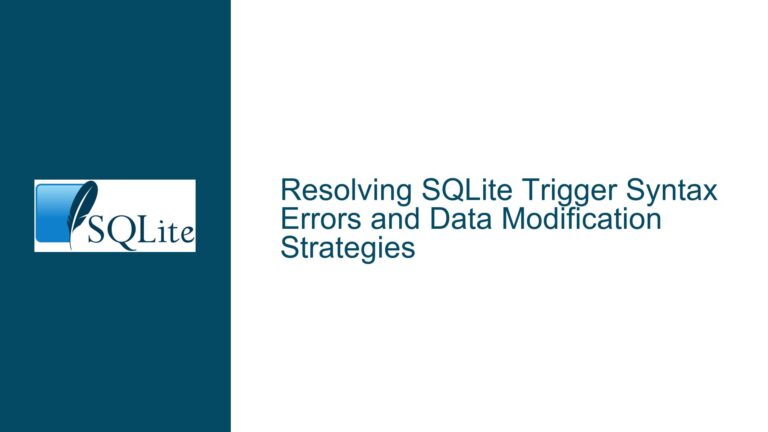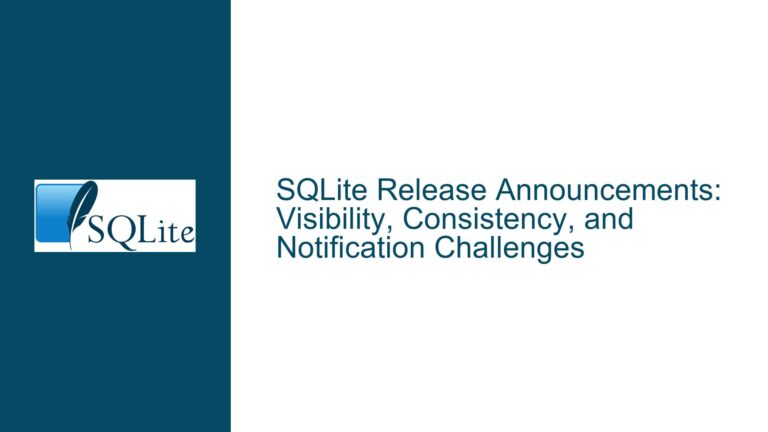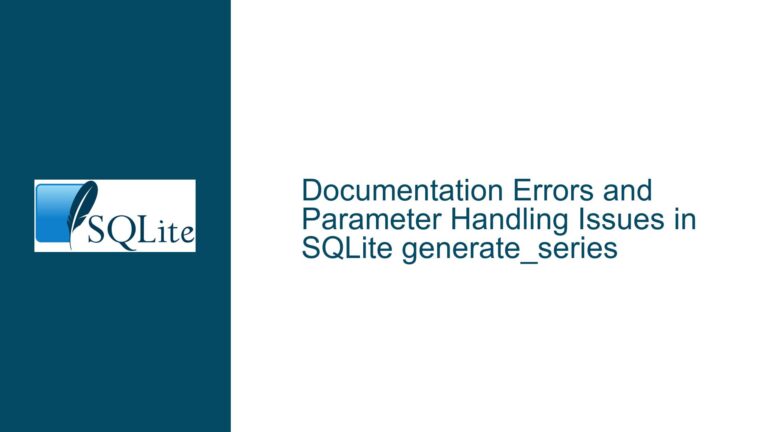Migrating from SQLCE to SQLite: Handling Missing Engine and Classes
Understanding the Transition from SQLCE to SQLite
When migrating a database from SQL Server Compact Edition (SQLCE) to SQLite, one of the most significant challenges is the absence of certain SQLCE-specific features and classes in SQLite. SQLCE provides a set of classes and methods, such as SQLCeEngine, ExecuteResultSet, ResultSetOptions, SqlCeUpdatableRecord, and SqlCeResultSet, which are not directly available in SQLite. This discrepancy necessitates a deep understanding of both database systems and a strategic approach to reimplementing or adapting the functionality provided by these classes in SQLite.
SQLite, being a lightweight, serverless, and self-contained database engine, operates differently from SQLCE. It does not have a direct equivalent to the SQLCeEngine class, which in SQLCE is responsible for database creation, compaction, and other engine-level operations. Similarly, SQLite does not have built-in support for updatable result sets or the specific result set manipulation methods available in SQLCE. This means that developers must rethink their approach to database operations when migrating to SQLite.
Identifying the Core Functionality Gaps
The core issue revolves around the absence of direct equivalents to SQLCE’s ExecuteResultSet, ResultSetOptions, SqlCeUpdatableRecord, and SqlCeResultSet in SQLite. These classes and methods in SQLCE are designed to facilitate efficient data retrieval, manipulation, and updating within a result set. In SQLite, the paradigm shifts towards a more straightforward, SQL-based approach where result sets are typically handled using standard SQL queries and cursors.
In SQLCE, ExecuteResultSet is used to execute a query and return a result set that can be navigated and updated. ResultSetOptions allows developers to specify how the result set should be managed, such as whether it should be updatable. SqlCeUpdatableRecord and SqlCeResultSet provide mechanisms for updating records directly within the result set. These features are particularly useful in scenarios where data needs to be manipulated in memory before being committed to the database.
In SQLite, however, the approach is more aligned with traditional SQL operations. Instead of using updatable result sets, developers typically execute SQL statements directly to insert, update, or delete records. This requires a shift in mindset and a reevaluation of how data is handled within the application. The lack of direct equivalents in SQLite means that developers must either find alternative methods to achieve the same functionality or redesign parts of their application to align with SQLite’s capabilities.
Strategies for Reimplementing SQLCE Functionality in SQLite
To address the functionality gaps, developers can adopt several strategies when migrating from SQLCE to SQLite. One approach is to leverage SQLite’s C API, which provides low-level access to database operations. By using functions such as sqlite3_prepare_v2(), sqlite3_step(), and sqlite3_finalize(), developers can create custom routines that mimic the behavior of SQLCE’s result set manipulation methods. However, this approach requires a deep understanding of SQLite’s C API and may involve significant code changes.
Another strategy is to use higher-level libraries or wrappers that abstract away some of the complexities of SQLite’s C API. For example, the System.Data.SQLite library provides a .NET wrapper around SQLite, offering a more familiar interface for developers accustomed to working with ADO.NET. This library can simplify the process of executing SQL statements and handling result sets, although it may not provide direct equivalents to all SQLCE features.
In cases where updatable result sets are essential, developers can implement custom logic to achieve similar functionality. This might involve retrieving data into memory, manipulating it as needed, and then executing the appropriate SQL statements to update the database. While this approach can be more resource-intensive, it allows for greater flexibility and control over data manipulation.
Detailed Troubleshooting Steps, Solutions & Fixes
Step 1: Assessing the Application’s Dependencies on SQLCE Features
Before attempting to migrate, it is crucial to conduct a thorough assessment of the application’s dependencies on SQLCE-specific features. This involves identifying all instances where ExecuteResultSet, ResultSetOptions, SqlCeUpdatableRecord, and SqlCeResultSet are used. Understanding the context in which these classes and methods are employed will help in determining the best approach for reimplementation in SQLite.
For example, if ExecuteResultSet is primarily used for querying data and displaying it in a user interface, the migration might involve replacing it with standard SQL queries and data binding mechanisms in SQLite. On the other hand, if SqlCeUpdatableRecord is used for in-memory data manipulation, the migration might require implementing custom logic to handle updates in SQLite.
Step 2: Exploring SQLite’s C API and Higher-Level Libraries
Once the dependencies have been identified, the next step is to explore SQLite’s C API and higher-level libraries to determine the best approach for reimplementation. The C API provides a comprehensive set of functions for database operations, but it requires a solid understanding of C programming and SQLite’s internal workings.
For developers more comfortable with .NET, the System.Data.SQLite library offers a more accessible alternative. This library provides a managed wrapper around SQLite, allowing developers to interact with the database using familiar ADO.NET classes such as SQLiteConnection, SQLiteCommand, and SQLiteDataReader. By leveraging this library, developers can simplify the migration process and reduce the amount of low-level code that needs to be written.
Step 3: Implementing Custom Logic for Updatable Result Sets
In cases where updatable result sets are essential, developers can implement custom logic to achieve similar functionality in SQLite. This might involve retrieving data into memory, manipulating it as needed, and then executing the appropriate SQL statements to update the database.
For example, instead of using SqlCeUpdatableRecord to update records directly within a result set, developers can retrieve the data into a DataTable or a similar in-memory data structure, make the necessary changes, and then execute UPDATE statements to persist the changes to the database. While this approach can be more resource-intensive, it provides the flexibility needed to handle complex data manipulation scenarios.
Step 4: Testing and Validating the Migration
After implementing the necessary changes, it is crucial to thoroughly test and validate the migration to ensure that the application functions as expected. This involves running a series of tests to verify that data is being retrieved, manipulated, and updated correctly in SQLite.
Testing should cover all aspects of the application’s database operations, including querying, inserting, updating, and deleting records. It is also important to test edge cases and error handling to ensure that the application can gracefully handle unexpected situations.
Step 5: Optimizing Performance and Resource Usage
Once the migration has been validated, the final step is to optimize the performance and resource usage of the application. This involves analyzing the database operations and identifying any potential bottlenecks or inefficiencies.
For example, if the application is performing a large number of small updates, it might be beneficial to batch these updates into a single transaction to reduce the overhead associated with committing each change individually. Similarly, if the application is retrieving large result sets, it might be necessary to implement pagination or other techniques to reduce memory usage.
By carefully optimizing the application’s database operations, developers can ensure that it performs efficiently and reliably in the SQLite environment.
Conclusion
Migrating from SQLCE to SQLite presents several challenges, particularly when it comes to reimplementing SQLCE-specific features such as ExecuteResultSet, ResultSetOptions, SqlCeUpdatableRecord, and SqlCeResultSet. However, by understanding the core functionality gaps, exploring SQLite’s C API and higher-level libraries, and implementing custom logic where necessary, developers can successfully transition their applications to SQLite.
The key to a successful migration lies in thorough assessment, careful planning, and rigorous testing. By following the detailed troubleshooting steps outlined above, developers can ensure that their applications continue to function effectively and efficiently in the SQLite environment.
